Management Accounting Report for Nike Inc. - Costing and Budgeting
VerifiedAdded on 2022/06/08
|19
|6949
|53
Report
AI Summary
This report analyzes the management accounting practices of Nike Inc., a multinational corporation. It begins with an introduction to Nike and outlines the report's objectives. The core of the report focuses on cost analysis, defining various cost classifications such as direct materials, direct labor, manufacturing overhead, and variable versus fixed costs. It then delves into applying marginal and absorption costing techniques to prepare an income statement. The report also explores different planning tools used for budgetary control, including the use of budgets for planning, pricing strategies, and strategic planning using PEST analysis. Through these analyses, the report aims to provide insights into Nike's financial strategies and decision-making processes, concluding with a summary of the findings and a list of references.
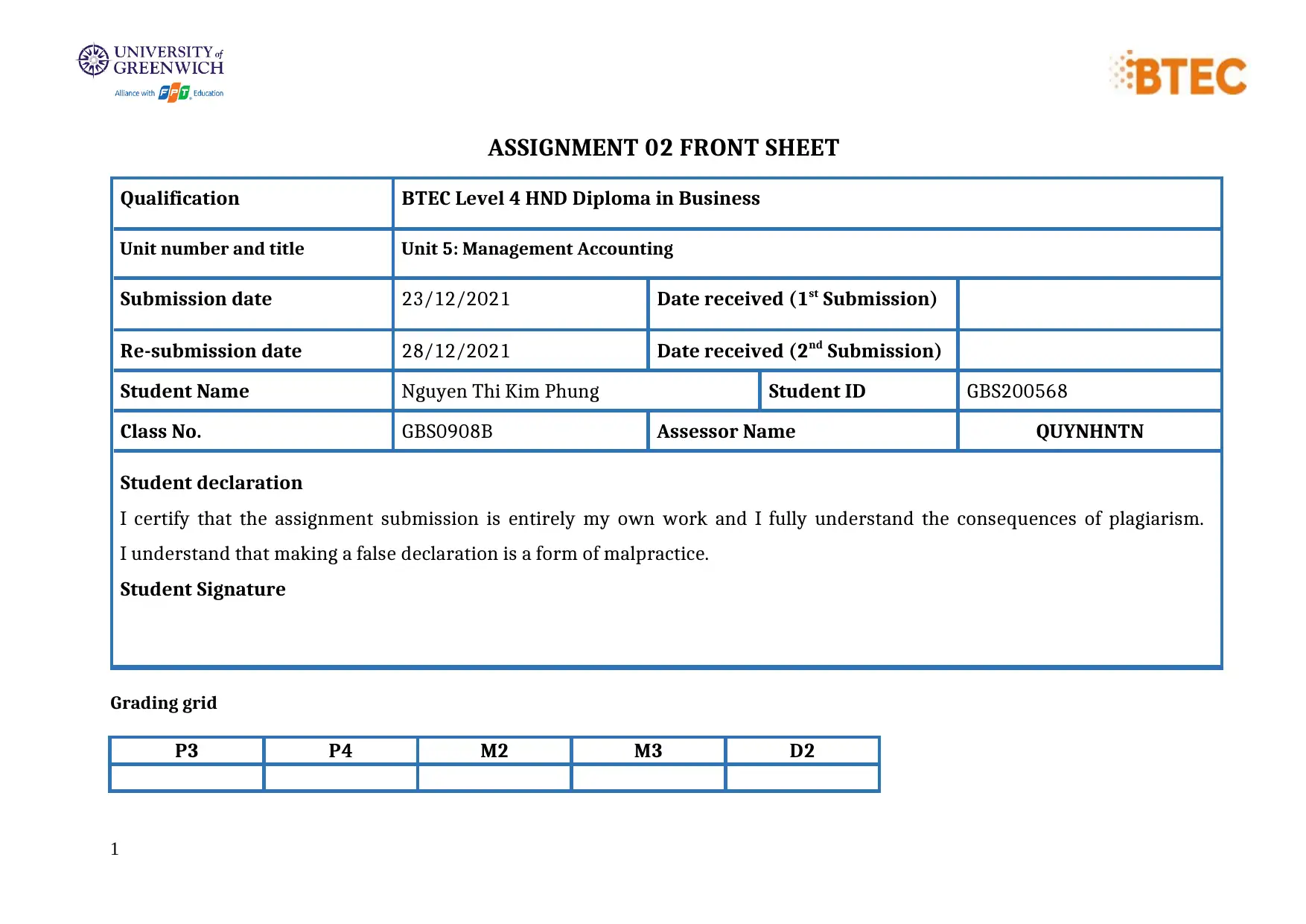
ASSIGNMENT 02 FRONT SHEET
Qualification BTEC Level 4 HND Diploma in Business
Unit number and title Unit 5: Management Accounting
Submission date 23/12/2021 Date received (1st Submission)
Re-submission date 28/12/2021 Date received (2nd Submission)
Student Name Nguyen Thi Kim Phung Student ID GBS200568
Class No. GBS0908B Assessor Name QUYNHNTN
Student declaration
I certify that the assignment submission is entirely my own work and I fully understand the consequences of plagiarism.
I understand that making a false declaration is a form of malpractice.
Student Signature
Grading grid
P3 P4 M2 M3 D2
1
Qualification BTEC Level 4 HND Diploma in Business
Unit number and title Unit 5: Management Accounting
Submission date 23/12/2021 Date received (1st Submission)
Re-submission date 28/12/2021 Date received (2nd Submission)
Student Name Nguyen Thi Kim Phung Student ID GBS200568
Class No. GBS0908B Assessor Name QUYNHNTN
Student declaration
I certify that the assignment submission is entirely my own work and I fully understand the consequences of plagiarism.
I understand that making a false declaration is a form of malpractice.
Student Signature
Grading grid
P3 P4 M2 M3 D2
1
Paraphrase This Document
Need a fresh take? Get an instant paraphrase of this document with our AI Paraphraser
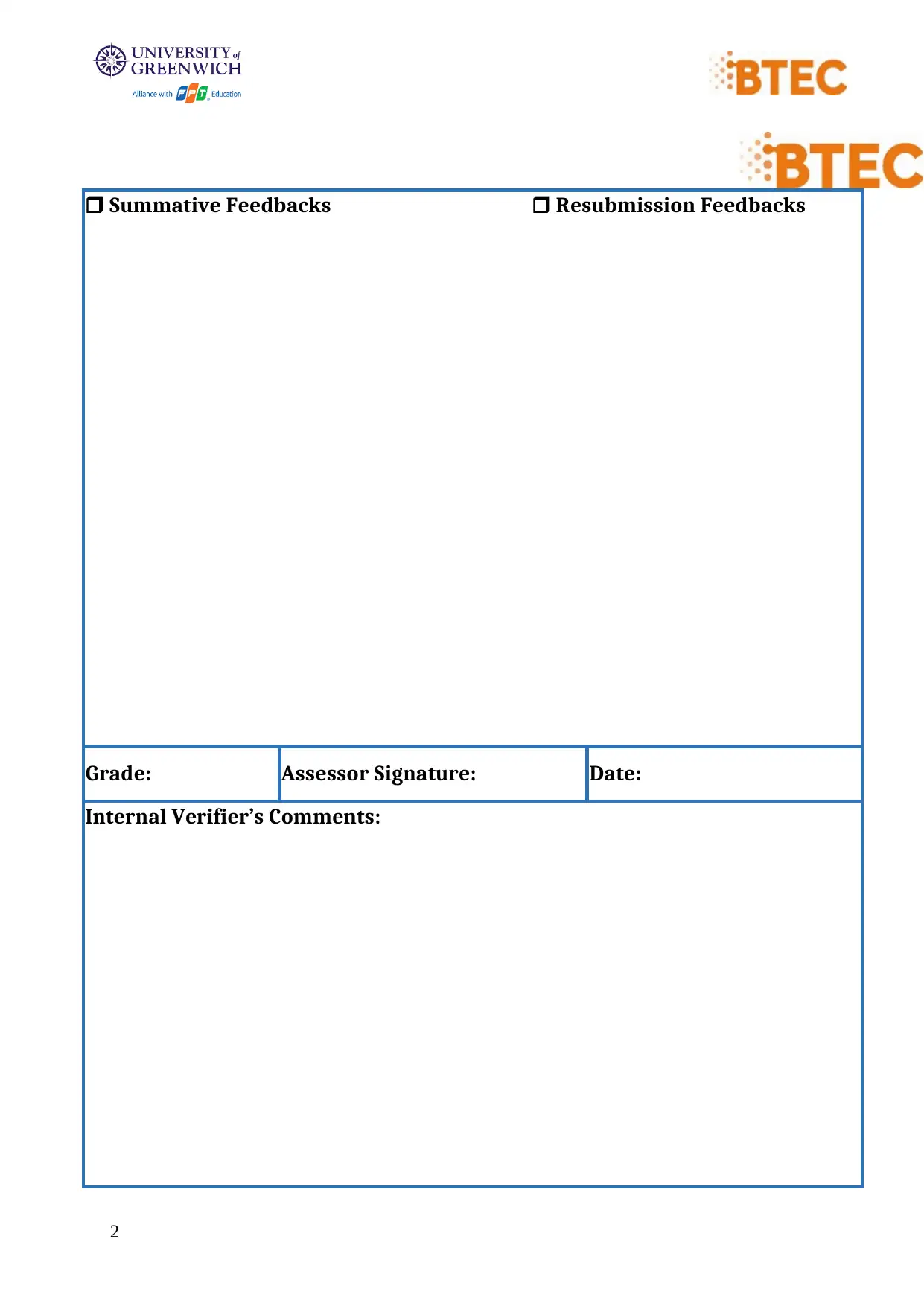
Summative Feedbacks Resubmission Feedbacks
Grade: Assessor Signature: Date:
Internal Verifier’s Comments:
2
Grade: Assessor Signature: Date:
Internal Verifier’s Comments:
2

Signature & Date:
Table of Contents
I. Introduction....................................................................................................................3
1. Ojective and content of report..................................................................................................3
2. Short introduction for Nike, Inc.................................................................................................3
II. Calculate costs using appropriate techniques of cost analysis to prepare an income
statement using marginal and absorption costs......................................................................4
1. Definion of costs........................................................................................................................4
2. Different costs...........................................................................................................................4
3. Cost-volume profit and cost variances.......................................................................................6
4. Applying absorption and marginal costing (variable costing).....................................................7
III. Explain the advantages and disadvantages of different types of planning tools used
for budgetary control..............................................................................................................8
1. Using budgets for planning and control.....................................................................................8
2. Pricing......................................................................................................................................11
3. Strategic planning ( PEST ).......................................................................................................12
IV. Conclusion.................................................................................................................13
V. References.....................................................................................................................13
I. Introduction
1. Ojective and content of report
Nike, Inc. is a multinational corporation established in the United States that designs,
develops, manufactures, and sells clothes, footwear, accessories, equipment, and services
worldwide. I work to increase the accounting department's efficiency as a member of Nike's
board of directors. The goal of this research was to give information about Nike's varied
budgeting and costing procedures.
2. Short introduction for Nike, Inc
3
Table of Contents
I. Introduction....................................................................................................................3
1. Ojective and content of report..................................................................................................3
2. Short introduction for Nike, Inc.................................................................................................3
II. Calculate costs using appropriate techniques of cost analysis to prepare an income
statement using marginal and absorption costs......................................................................4
1. Definion of costs........................................................................................................................4
2. Different costs...........................................................................................................................4
3. Cost-volume profit and cost variances.......................................................................................6
4. Applying absorption and marginal costing (variable costing).....................................................7
III. Explain the advantages and disadvantages of different types of planning tools used
for budgetary control..............................................................................................................8
1. Using budgets for planning and control.....................................................................................8
2. Pricing......................................................................................................................................11
3. Strategic planning ( PEST ).......................................................................................................12
IV. Conclusion.................................................................................................................13
V. References.....................................................................................................................13
I. Introduction
1. Ojective and content of report
Nike, Inc. is a multinational corporation established in the United States that designs,
develops, manufactures, and sells clothes, footwear, accessories, equipment, and services
worldwide. I work to increase the accounting department's efficiency as a member of Nike's
board of directors. The goal of this research was to give information about Nike's varied
budgeting and costing procedures.
2. Short introduction for Nike, Inc
3
⊘ This is a preview!⊘
Do you want full access?
Subscribe today to unlock all pages.

Trusted by 1+ million students worldwide
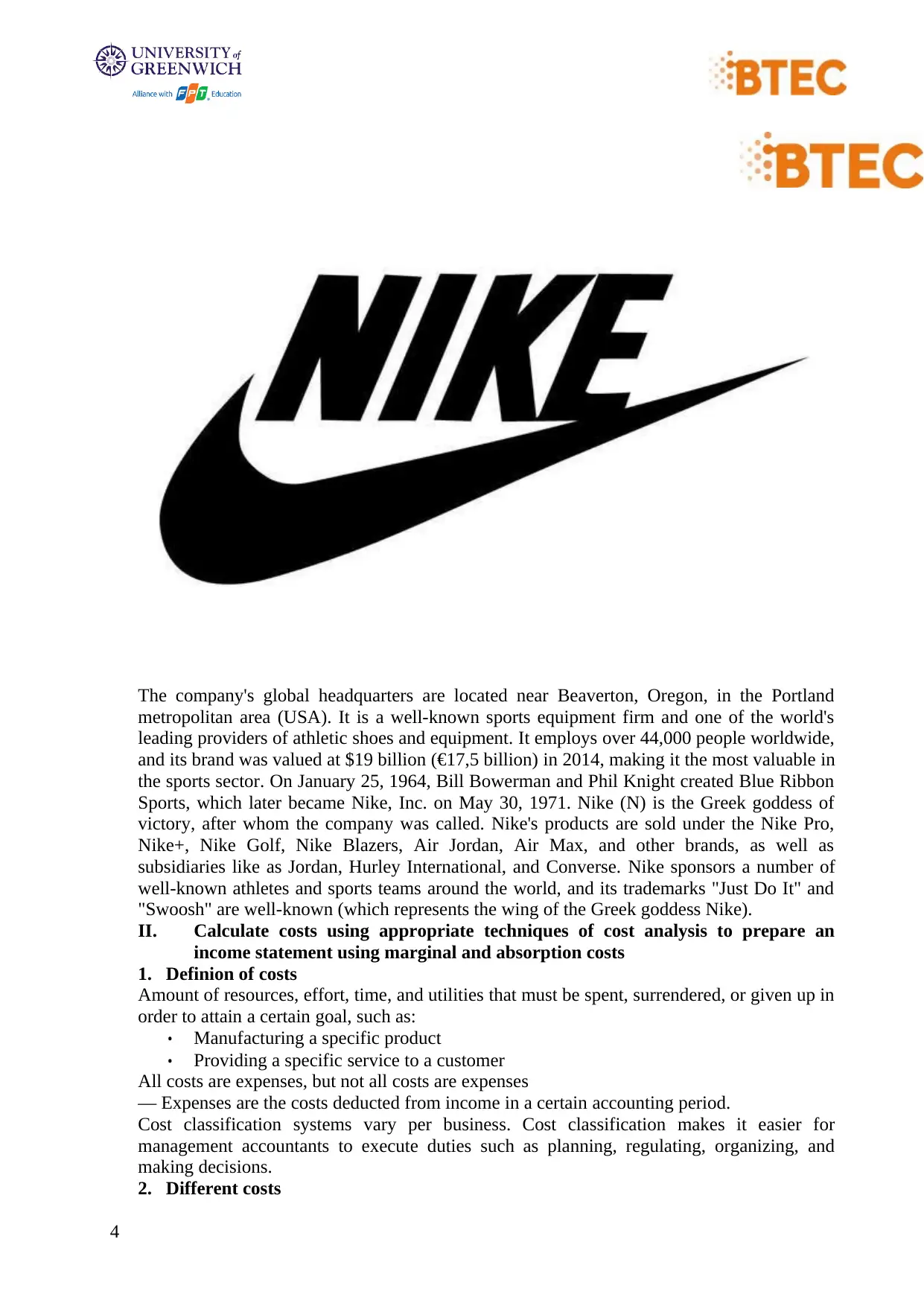
The company's global headquarters are located near Beaverton, Oregon, in the Portland
metropolitan area (USA). It is a well-known sports equipment firm and one of the world's
leading providers of athletic shoes and equipment. It employs over 44,000 people worldwide,
and its brand was valued at $19 billion (€17,5 billion) in 2014, making it the most valuable in
the sports sector. On January 25, 1964, Bill Bowerman and Phil Knight created Blue Ribbon
Sports, which later became Nike, Inc. on May 30, 1971. Nike (N) is the Greek goddess of
victory, after whom the company was called. Nike's products are sold under the Nike Pro,
Nike+, Nike Golf, Nike Blazers, Air Jordan, Air Max, and other brands, as well as
subsidiaries like as Jordan, Hurley International, and Converse. Nike sponsors a number of
well-known athletes and sports teams around the world, and its trademarks "Just Do It" and
"Swoosh" are well-known (which represents the wing of the Greek goddess Nike).
II. Calculate costs using appropriate techniques of cost analysis to prepare an
income statement using marginal and absorption costs
1. Definion of costs
Amount of resources, effort, time, and utilities that must be spent, surrendered, or given up in
order to attain a certain goal, such as:
• Manufacturing a specific product
• Providing a specific service to a customer
All costs are expenses, but not all costs are expenses
— Expenses are the costs deducted from income in a certain accounting period.
Cost classification systems vary per business. Cost classification makes it easier for
management accountants to execute duties such as planning, regulating, organizing, and
making decisions.
2. Different costs
4
metropolitan area (USA). It is a well-known sports equipment firm and one of the world's
leading providers of athletic shoes and equipment. It employs over 44,000 people worldwide,
and its brand was valued at $19 billion (€17,5 billion) in 2014, making it the most valuable in
the sports sector. On January 25, 1964, Bill Bowerman and Phil Knight created Blue Ribbon
Sports, which later became Nike, Inc. on May 30, 1971. Nike (N) is the Greek goddess of
victory, after whom the company was called. Nike's products are sold under the Nike Pro,
Nike+, Nike Golf, Nike Blazers, Air Jordan, Air Max, and other brands, as well as
subsidiaries like as Jordan, Hurley International, and Converse. Nike sponsors a number of
well-known athletes and sports teams around the world, and its trademarks "Just Do It" and
"Swoosh" are well-known (which represents the wing of the Greek goddess Nike).
II. Calculate costs using appropriate techniques of cost analysis to prepare an
income statement using marginal and absorption costs
1. Definion of costs
Amount of resources, effort, time, and utilities that must be spent, surrendered, or given up in
order to attain a certain goal, such as:
• Manufacturing a specific product
• Providing a specific service to a customer
All costs are expenses, but not all costs are expenses
— Expenses are the costs deducted from income in a certain accounting period.
Cost classification systems vary per business. Cost classification makes it easier for
management accountants to execute duties such as planning, regulating, organizing, and
making decisions.
2. Different costs
4
Paraphrase This Document
Need a fresh take? Get an instant paraphrase of this document with our AI Paraphraser
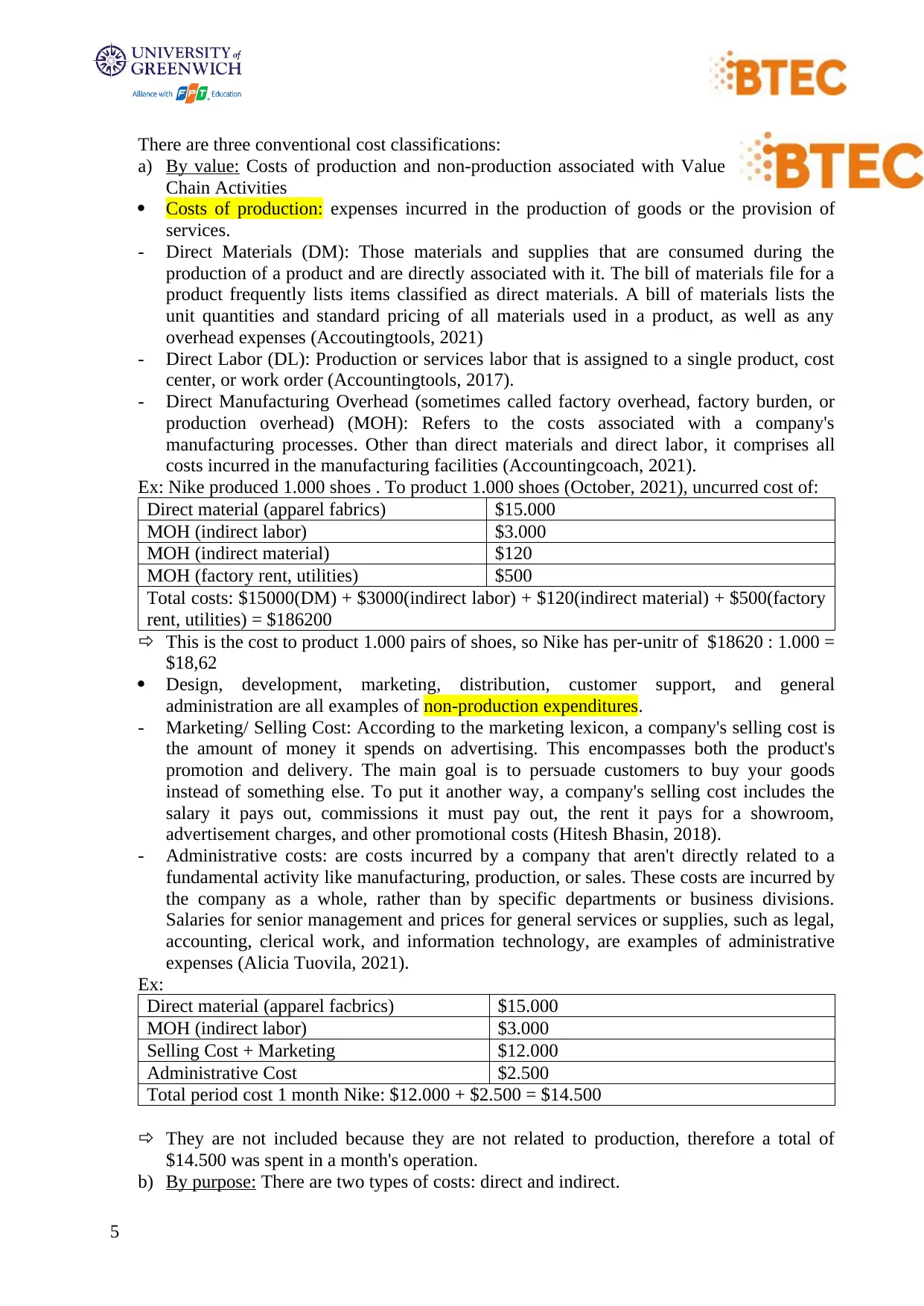
There are three conventional cost classifications:
a) By value: Costs of production and non-production associated with Value
Chain Activities
Costs of production: expenses incurred in the production of goods or the provision of
services.
- Direct Materials (DM): Those materials and supplies that are consumed during the
production of a product and are directly associated with it. The bill of materials file for a
product frequently lists items classified as direct materials. A bill of materials lists the
unit quantities and standard pricing of all materials used in a product, as well as any
overhead expenses (Accoutingtools, 2021)
- Direct Labor (DL): Production or services labor that is assigned to a single product, cost
center, or work order (Accountingtools, 2017).
- Direct Manufacturing Overhead (sometimes called factory overhead, factory burden, or
production overhead) (MOH): Refers to the costs associated with a company's
manufacturing processes. Other than direct materials and direct labor, it comprises all
costs incurred in the manufacturing facilities (Accountingcoach, 2021).
Ex: Nike produced 1.000 shoes . To product 1.000 shoes (October, 2021), uncurred cost of:
Direct material (apparel fabrics) $15.000
MOH (indirect labor) $3.000
MOH (indirect material) $120
MOH (factory rent, utilities) $500
Total costs: $15000(DM) + $3000(indirect labor) + $120(indirect material) + $500(factory
rent, utilities) = $186200
This is the cost to product 1.000 pairs of shoes, so Nike has per-unitr of $18620 : 1.000 =
$18,62
Design, development, marketing, distribution, customer support, and general
administration are all examples of non-production expenditures.
- Marketing/ Selling Cost: According to the marketing lexicon, a company's selling cost is
the amount of money it spends on advertising. This encompasses both the product's
promotion and delivery. The main goal is to persuade customers to buy your goods
instead of something else. To put it another way, a company's selling cost includes the
salary it pays out, commissions it must pay out, the rent it pays for a showroom,
advertisement charges, and other promotional costs (Hitesh Bhasin, 2018).
- Administrative costs: are costs incurred by a company that aren't directly related to a
fundamental activity like manufacturing, production, or sales. These costs are incurred by
the company as a whole, rather than by specific departments or business divisions.
Salaries for senior management and prices for general services or supplies, such as legal,
accounting, clerical work, and information technology, are examples of administrative
expenses (Alicia Tuovila, 2021).
Ex:
Direct material (apparel facbrics) $15.000
MOH (indirect labor) $3.000
Selling Cost + Marketing $12.000
Administrative Cost $2.500
Total period cost 1 month Nike: $12.000 + $2.500 = $14.500
They are not included because they are not related to production, therefore a total of
$14.500 was spent in a month's operation.
b) By purpose: There are two types of costs: direct and indirect.
5
a) By value: Costs of production and non-production associated with Value
Chain Activities
Costs of production: expenses incurred in the production of goods or the provision of
services.
- Direct Materials (DM): Those materials and supplies that are consumed during the
production of a product and are directly associated with it. The bill of materials file for a
product frequently lists items classified as direct materials. A bill of materials lists the
unit quantities and standard pricing of all materials used in a product, as well as any
overhead expenses (Accoutingtools, 2021)
- Direct Labor (DL): Production or services labor that is assigned to a single product, cost
center, or work order (Accountingtools, 2017).
- Direct Manufacturing Overhead (sometimes called factory overhead, factory burden, or
production overhead) (MOH): Refers to the costs associated with a company's
manufacturing processes. Other than direct materials and direct labor, it comprises all
costs incurred in the manufacturing facilities (Accountingcoach, 2021).
Ex: Nike produced 1.000 shoes . To product 1.000 shoes (October, 2021), uncurred cost of:
Direct material (apparel fabrics) $15.000
MOH (indirect labor) $3.000
MOH (indirect material) $120
MOH (factory rent, utilities) $500
Total costs: $15000(DM) + $3000(indirect labor) + $120(indirect material) + $500(factory
rent, utilities) = $186200
This is the cost to product 1.000 pairs of shoes, so Nike has per-unitr of $18620 : 1.000 =
$18,62
Design, development, marketing, distribution, customer support, and general
administration are all examples of non-production expenditures.
- Marketing/ Selling Cost: According to the marketing lexicon, a company's selling cost is
the amount of money it spends on advertising. This encompasses both the product's
promotion and delivery. The main goal is to persuade customers to buy your goods
instead of something else. To put it another way, a company's selling cost includes the
salary it pays out, commissions it must pay out, the rent it pays for a showroom,
advertisement charges, and other promotional costs (Hitesh Bhasin, 2018).
- Administrative costs: are costs incurred by a company that aren't directly related to a
fundamental activity like manufacturing, production, or sales. These costs are incurred by
the company as a whole, rather than by specific departments or business divisions.
Salaries for senior management and prices for general services or supplies, such as legal,
accounting, clerical work, and information technology, are examples of administrative
expenses (Alicia Tuovila, 2021).
Ex:
Direct material (apparel facbrics) $15.000
MOH (indirect labor) $3.000
Selling Cost + Marketing $12.000
Administrative Cost $2.500
Total period cost 1 month Nike: $12.000 + $2.500 = $14.500
They are not included because they are not related to production, therefore a total of
$14.500 was spent in a month's operation.
b) By purpose: There are two types of costs: direct and indirect.
5
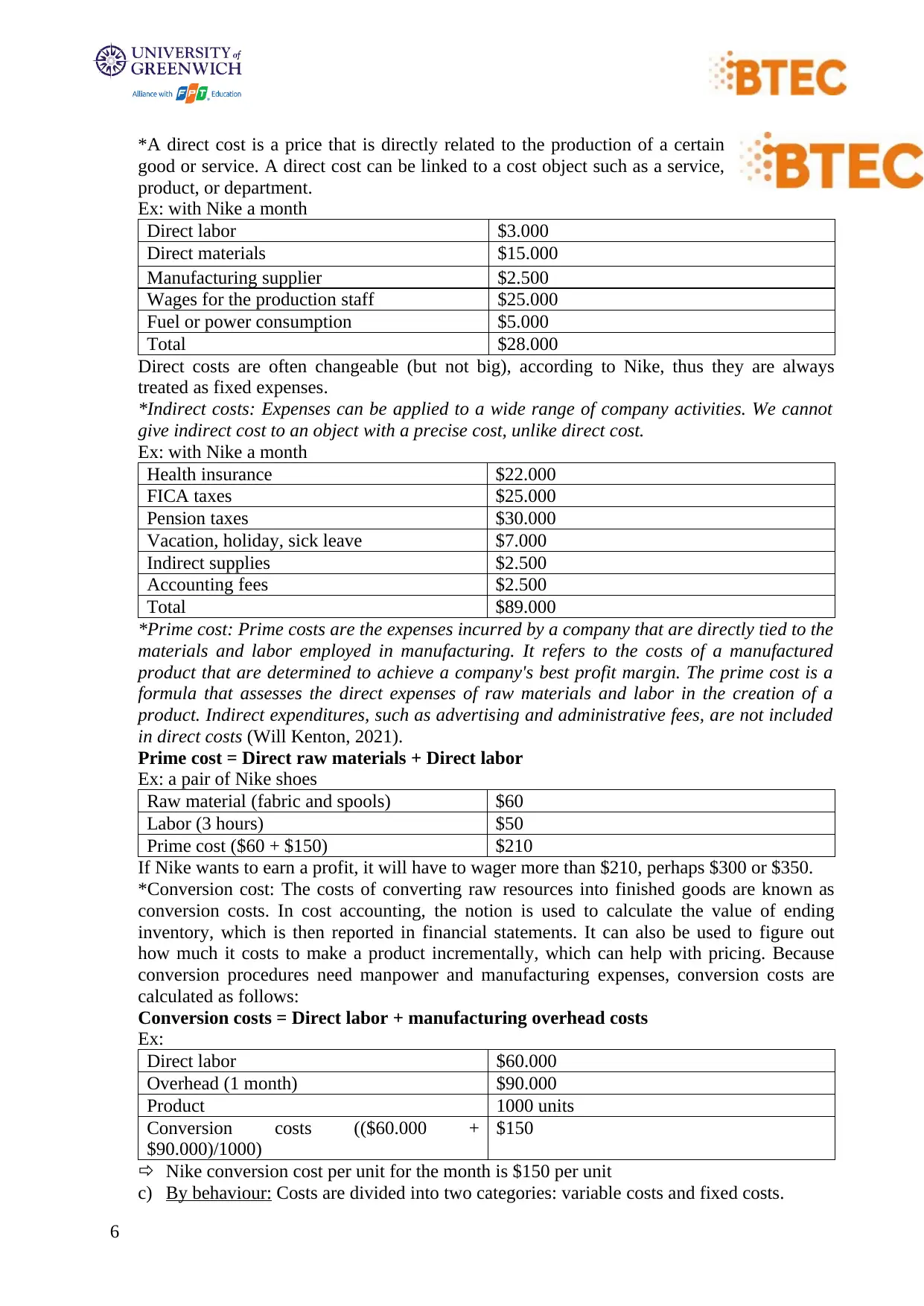
*A direct cost is a price that is directly related to the production of a certain
good or service. A direct cost can be linked to a cost object such as a service,
product, or department.
Ex: with Nike a month
Direct labor $3.000
Direct materials $15.000
Manufacturing supplier $2.500
Wages for the production staff $25.000
Fuel or power consumption $5.000
Total $28.000
Direct costs are often changeable (but not big), according to Nike, thus they are always
treated as fixed expenses.
*Indirect costs: Expenses can be applied to a wide range of company activities. We cannot
give indirect cost to an object with a precise cost, unlike direct cost.
Ex: with Nike a month
Health insurance $22.000
FICA taxes $25.000
Pension taxes $30.000
Vacation, holiday, sick leave $7.000
Indirect supplies $2.500
Accounting fees $2.500
Total $89.000
*Prime cost: Prime costs are the expenses incurred by a company that are directly tied to the
materials and labor employed in manufacturing. It refers to the costs of a manufactured
product that are determined to achieve a company's best profit margin. The prime cost is a
formula that assesses the direct expenses of raw materials and labor in the creation of a
product. Indirect expenditures, such as advertising and administrative fees, are not included
in direct costs (Will Kenton, 2021).
Prime cost = Direct raw materials + Direct labor
Ex: a pair of Nike shoes
Raw material (fabric and spools) $60
Labor (3 hours) $50
Prime cost ($60 + $150) $210
If Nike wants to earn a profit, it will have to wager more than $210, perhaps $300 or $350.
*Conversion cost: The costs of converting raw resources into finished goods are known as
conversion costs. In cost accounting, the notion is used to calculate the value of ending
inventory, which is then reported in financial statements. It can also be used to figure out
how much it costs to make a product incrementally, which can help with pricing. Because
conversion procedures need manpower and manufacturing expenses, conversion costs are
calculated as follows:
Conversion costs = Direct labor + manufacturing overhead costs
Ex:
Direct labor $60.000
Overhead (1 month) $90.000
Product 1000 units
Conversion costs (($60.000 +
$90.000)/1000)
$150
Nike conversion cost per unit for the month is $150 per unit
c) By behaviour: Costs are divided into two categories: variable costs and fixed costs.
6
good or service. A direct cost can be linked to a cost object such as a service,
product, or department.
Ex: with Nike a month
Direct labor $3.000
Direct materials $15.000
Manufacturing supplier $2.500
Wages for the production staff $25.000
Fuel or power consumption $5.000
Total $28.000
Direct costs are often changeable (but not big), according to Nike, thus they are always
treated as fixed expenses.
*Indirect costs: Expenses can be applied to a wide range of company activities. We cannot
give indirect cost to an object with a precise cost, unlike direct cost.
Ex: with Nike a month
Health insurance $22.000
FICA taxes $25.000
Pension taxes $30.000
Vacation, holiday, sick leave $7.000
Indirect supplies $2.500
Accounting fees $2.500
Total $89.000
*Prime cost: Prime costs are the expenses incurred by a company that are directly tied to the
materials and labor employed in manufacturing. It refers to the costs of a manufactured
product that are determined to achieve a company's best profit margin. The prime cost is a
formula that assesses the direct expenses of raw materials and labor in the creation of a
product. Indirect expenditures, such as advertising and administrative fees, are not included
in direct costs (Will Kenton, 2021).
Prime cost = Direct raw materials + Direct labor
Ex: a pair of Nike shoes
Raw material (fabric and spools) $60
Labor (3 hours) $50
Prime cost ($60 + $150) $210
If Nike wants to earn a profit, it will have to wager more than $210, perhaps $300 or $350.
*Conversion cost: The costs of converting raw resources into finished goods are known as
conversion costs. In cost accounting, the notion is used to calculate the value of ending
inventory, which is then reported in financial statements. It can also be used to figure out
how much it costs to make a product incrementally, which can help with pricing. Because
conversion procedures need manpower and manufacturing expenses, conversion costs are
calculated as follows:
Conversion costs = Direct labor + manufacturing overhead costs
Ex:
Direct labor $60.000
Overhead (1 month) $90.000
Product 1000 units
Conversion costs (($60.000 +
$90.000)/1000)
$150
Nike conversion cost per unit for the month is $150 per unit
c) By behaviour: Costs are divided into two categories: variable costs and fixed costs.
6
⊘ This is a preview!⊘
Do you want full access?
Subscribe today to unlock all pages.

Trusted by 1+ million students worldwide
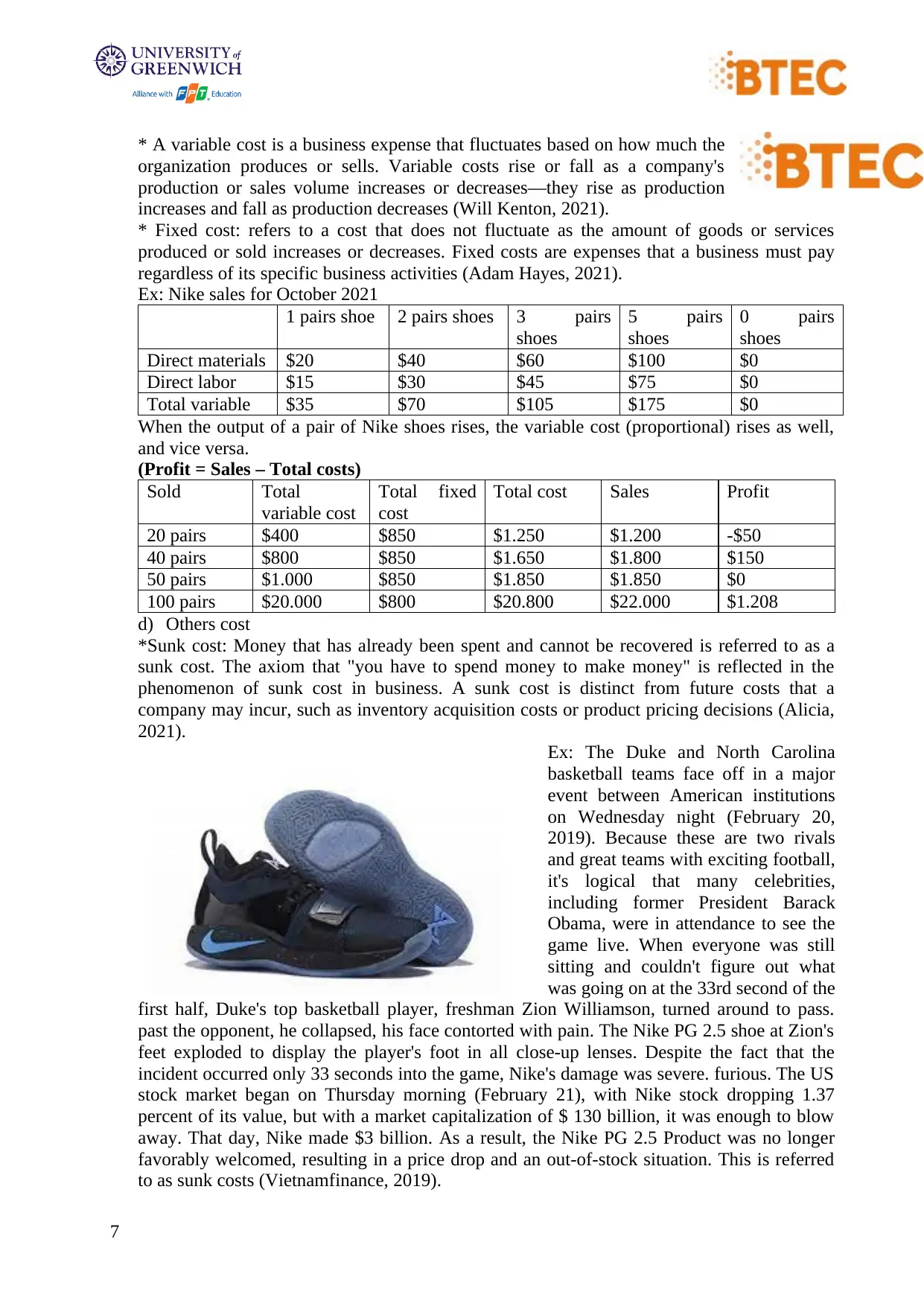
* A variable cost is a business expense that fluctuates based on how much the
organization produces or sells. Variable costs rise or fall as a company's
production or sales volume increases or decreases—they rise as production
increases and fall as production decreases (Will Kenton, 2021).
* Fixed cost: refers to a cost that does not fluctuate as the amount of goods or services
produced or sold increases or decreases. Fixed costs are expenses that a business must pay
regardless of its specific business activities (Adam Hayes, 2021).
Ex: Nike sales for October 2021
1 pairs shoe 2 pairs shoes 3 pairs
shoes
5 pairs
shoes
0 pairs
shoes
Direct materials $20 $40 $60 $100 $0
Direct labor $15 $30 $45 $75 $0
Total variable $35 $70 $105 $175 $0
When the output of a pair of Nike shoes rises, the variable cost (proportional) rises as well,
and vice versa.
(Profit = Sales – Total costs)
Sold Total
variable cost
Total fixed
cost
Total cost Sales Profit
20 pairs $400 $850 $1.250 $1.200 -$50
40 pairs $800 $850 $1.650 $1.800 $150
50 pairs $1.000 $850 $1.850 $1.850 $0
100 pairs $20.000 $800 $20.800 $22.000 $1.208
d) Others cost
*Sunk cost: Money that has already been spent and cannot be recovered is referred to as a
sunk cost. The axiom that "you have to spend money to make money" is reflected in the
phenomenon of sunk cost in business. A sunk cost is distinct from future costs that a
company may incur, such as inventory acquisition costs or product pricing decisions (Alicia,
2021).
Ex: The Duke and North Carolina
basketball teams face off in a major
event between American institutions
on Wednesday night (February 20,
2019). Because these are two rivals
and great teams with exciting football,
it's logical that many celebrities,
including former President Barack
Obama, were in attendance to see the
game live. When everyone was still
sitting and couldn't figure out what
was going on at the 33rd second of the
first half, Duke's top basketball player, freshman Zion Williamson, turned around to pass.
past the opponent, he collapsed, his face contorted with pain. The Nike PG 2.5 shoe at Zion's
feet exploded to display the player's foot in all close-up lenses. Despite the fact that the
incident occurred only 33 seconds into the game, Nike's damage was severe. furious. The US
stock market began on Thursday morning (February 21), with Nike stock dropping 1.37
percent of its value, but with a market capitalization of $ 130 billion, it was enough to blow
away. That day, Nike made $3 billion. As a result, the Nike PG 2.5 Product was no longer
favorably welcomed, resulting in a price drop and an out-of-stock situation. This is referred
to as sunk costs (Vietnamfinance, 2019).
7
organization produces or sells. Variable costs rise or fall as a company's
production or sales volume increases or decreases—they rise as production
increases and fall as production decreases (Will Kenton, 2021).
* Fixed cost: refers to a cost that does not fluctuate as the amount of goods or services
produced or sold increases or decreases. Fixed costs are expenses that a business must pay
regardless of its specific business activities (Adam Hayes, 2021).
Ex: Nike sales for October 2021
1 pairs shoe 2 pairs shoes 3 pairs
shoes
5 pairs
shoes
0 pairs
shoes
Direct materials $20 $40 $60 $100 $0
Direct labor $15 $30 $45 $75 $0
Total variable $35 $70 $105 $175 $0
When the output of a pair of Nike shoes rises, the variable cost (proportional) rises as well,
and vice versa.
(Profit = Sales – Total costs)
Sold Total
variable cost
Total fixed
cost
Total cost Sales Profit
20 pairs $400 $850 $1.250 $1.200 -$50
40 pairs $800 $850 $1.650 $1.800 $150
50 pairs $1.000 $850 $1.850 $1.850 $0
100 pairs $20.000 $800 $20.800 $22.000 $1.208
d) Others cost
*Sunk cost: Money that has already been spent and cannot be recovered is referred to as a
sunk cost. The axiom that "you have to spend money to make money" is reflected in the
phenomenon of sunk cost in business. A sunk cost is distinct from future costs that a
company may incur, such as inventory acquisition costs or product pricing decisions (Alicia,
2021).
Ex: The Duke and North Carolina
basketball teams face off in a major
event between American institutions
on Wednesday night (February 20,
2019). Because these are two rivals
and great teams with exciting football,
it's logical that many celebrities,
including former President Barack
Obama, were in attendance to see the
game live. When everyone was still
sitting and couldn't figure out what
was going on at the 33rd second of the
first half, Duke's top basketball player, freshman Zion Williamson, turned around to pass.
past the opponent, he collapsed, his face contorted with pain. The Nike PG 2.5 shoe at Zion's
feet exploded to display the player's foot in all close-up lenses. Despite the fact that the
incident occurred only 33 seconds into the game, Nike's damage was severe. furious. The US
stock market began on Thursday morning (February 21), with Nike stock dropping 1.37
percent of its value, but with a market capitalization of $ 130 billion, it was enough to blow
away. That day, Nike made $3 billion. As a result, the Nike PG 2.5 Product was no longer
favorably welcomed, resulting in a price drop and an out-of-stock situation. This is referred
to as sunk costs (Vietnamfinance, 2019).
7
Paraphrase This Document
Need a fresh take? Get an instant paraphrase of this document with our AI Paraphraser
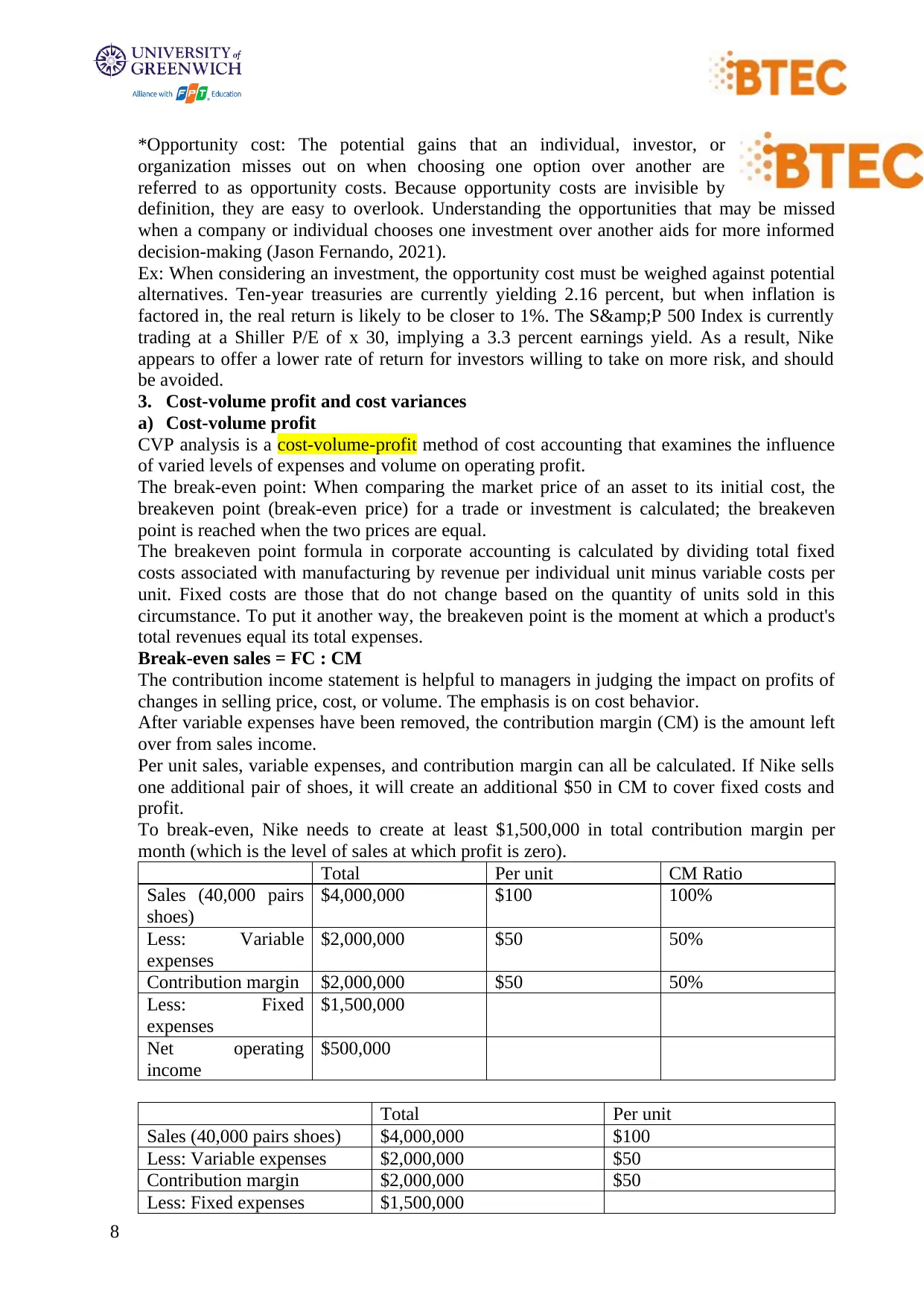
*Opportunity cost: The potential gains that an individual, investor, or
organization misses out on when choosing one option over another are
referred to as opportunity costs. Because opportunity costs are invisible by
definition, they are easy to overlook. Understanding the opportunities that may be missed
when a company or individual chooses one investment over another aids for more informed
decision-making (Jason Fernando, 2021).
Ex: When considering an investment, the opportunity cost must be weighed against potential
alternatives. Ten-year treasuries are currently yielding 2.16 percent, but when inflation is
factored in, the real return is likely to be closer to 1%. The S&P 500 Index is currently
trading at a Shiller P/E of x 30, implying a 3.3 percent earnings yield. As a result, Nike
appears to offer a lower rate of return for investors willing to take on more risk, and should
be avoided.
3. Cost-volume profit and cost variances
a) Cost-volume profit
CVP analysis is a cost-volume-profit method of cost accounting that examines the influence
of varied levels of expenses and volume on operating profit.
The break-even point: When comparing the market price of an asset to its initial cost, the
breakeven point (break-even price) for a trade or investment is calculated; the breakeven
point is reached when the two prices are equal.
The breakeven point formula in corporate accounting is calculated by dividing total fixed
costs associated with manufacturing by revenue per individual unit minus variable costs per
unit. Fixed costs are those that do not change based on the quantity of units sold in this
circumstance. To put it another way, the breakeven point is the moment at which a product's
total revenues equal its total expenses.
Break-even sales = FC : CM
The contribution income statement is helpful to managers in judging the impact on profits of
changes in selling price, cost, or volume. The emphasis is on cost behavior.
After variable expenses have been removed, the contribution margin (CM) is the amount left
over from sales income.
Per unit sales, variable expenses, and contribution margin can all be calculated. If Nike sells
one additional pair of shoes, it will create an additional $50 in CM to cover fixed costs and
profit.
To break-even, Nike needs to create at least $1,500,000 in total contribution margin per
month (which is the level of sales at which profit is zero).
Total Per unit CM Ratio
Sales (40,000 pairs
shoes)
$4,000,000 $100 100%
Less: Variable
expenses
$2,000,000 $50 50%
Contribution margin $2,000,000 $50 50%
Less: Fixed
expenses
$1,500,000
Net operating
income
$500,000
Total Per unit
Sales (40,000 pairs shoes) $4,000,000 $100
Less: Variable expenses $2,000,000 $50
Contribution margin $2,000,000 $50
Less: Fixed expenses $1,500,000
8
organization misses out on when choosing one option over another are
referred to as opportunity costs. Because opportunity costs are invisible by
definition, they are easy to overlook. Understanding the opportunities that may be missed
when a company or individual chooses one investment over another aids for more informed
decision-making (Jason Fernando, 2021).
Ex: When considering an investment, the opportunity cost must be weighed against potential
alternatives. Ten-year treasuries are currently yielding 2.16 percent, but when inflation is
factored in, the real return is likely to be closer to 1%. The S&P 500 Index is currently
trading at a Shiller P/E of x 30, implying a 3.3 percent earnings yield. As a result, Nike
appears to offer a lower rate of return for investors willing to take on more risk, and should
be avoided.
3. Cost-volume profit and cost variances
a) Cost-volume profit
CVP analysis is a cost-volume-profit method of cost accounting that examines the influence
of varied levels of expenses and volume on operating profit.
The break-even point: When comparing the market price of an asset to its initial cost, the
breakeven point (break-even price) for a trade or investment is calculated; the breakeven
point is reached when the two prices are equal.
The breakeven point formula in corporate accounting is calculated by dividing total fixed
costs associated with manufacturing by revenue per individual unit minus variable costs per
unit. Fixed costs are those that do not change based on the quantity of units sold in this
circumstance. To put it another way, the breakeven point is the moment at which a product's
total revenues equal its total expenses.
Break-even sales = FC : CM
The contribution income statement is helpful to managers in judging the impact on profits of
changes in selling price, cost, or volume. The emphasis is on cost behavior.
After variable expenses have been removed, the contribution margin (CM) is the amount left
over from sales income.
Per unit sales, variable expenses, and contribution margin can all be calculated. If Nike sells
one additional pair of shoes, it will create an additional $50 in CM to cover fixed costs and
profit.
To break-even, Nike needs to create at least $1,500,000 in total contribution margin per
month (which is the level of sales at which profit is zero).
Total Per unit CM Ratio
Sales (40,000 pairs
shoes)
$4,000,000 $100 100%
Less: Variable
expenses
$2,000,000 $50 50%
Contribution margin $2,000,000 $50 50%
Less: Fixed
expenses
$1,500,000
Net operating
income
$500,000
Total Per unit
Sales (40,000 pairs shoes) $4,000,000 $100
Less: Variable expenses $2,000,000 $50
Contribution margin $2,000,000 $50
Less: Fixed expenses $1,500,000
8
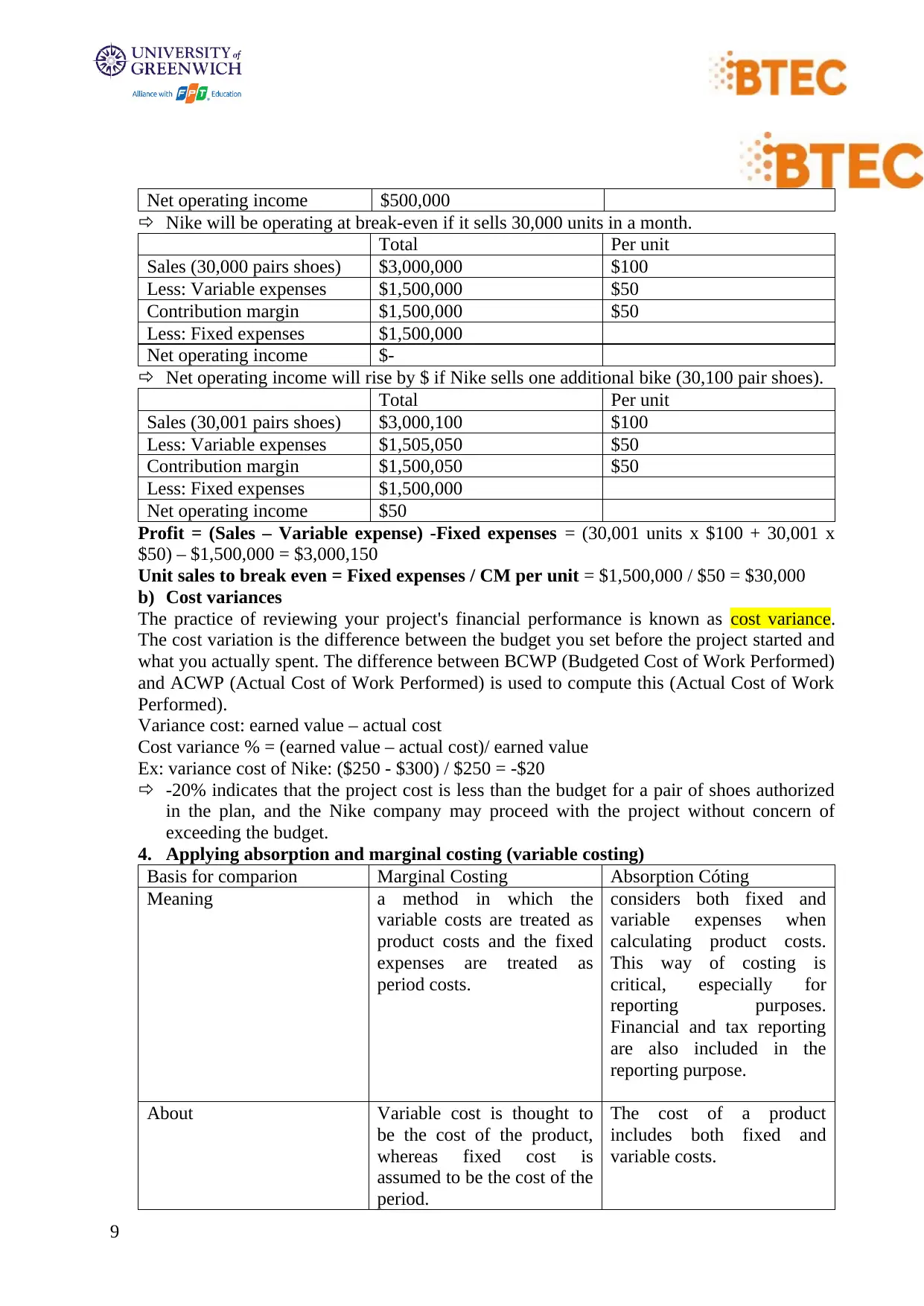
Net operating income $500,000
Nike will be operating at break-even if it sells 30,000 units in a month.
Total Per unit
Sales (30,000 pairs shoes) $3,000,000 $100
Less: Variable expenses $1,500,000 $50
Contribution margin $1,500,000 $50
Less: Fixed expenses $1,500,000
Net operating income $-
Net operating income will rise by $ if Nike sells one additional bike (30,100 pair shoes).
Total Per unit
Sales (30,001 pairs shoes) $3,000,100 $100
Less: Variable expenses $1,505,050 $50
Contribution margin $1,500,050 $50
Less: Fixed expenses $1,500,000
Net operating income $50
Profit = (Sales – Variable expense) -Fixed expenses = (30,001 units x $100 + 30,001 x
$50) – $1,500,000 = $3,000,150
Unit sales to break even = Fixed expenses / CM per unit = $1,500,000 / $50 = $30,000
b) Cost variances
The practice of reviewing your project's financial performance is known as cost variance.
The cost variation is the difference between the budget you set before the project started and
what you actually spent. The difference between BCWP (Budgeted Cost of Work Performed)
and ACWP (Actual Cost of Work Performed) is used to compute this (Actual Cost of Work
Performed).
Variance cost: earned value – actual cost
Cost variance % = (earned value – actual cost)/ earned value
Ex: variance cost of Nike: ($250 - $300) / $250 = -$20
-20% indicates that the project cost is less than the budget for a pair of shoes authorized
in the plan, and the Nike company may proceed with the project without concern of
exceeding the budget.
4. Applying absorption and marginal costing (variable costing)
Basis for comparion Marginal Costing Absorption Cóting
Meaning a method in which the
variable costs are treated as
product costs and the fixed
expenses are treated as
period costs.
considers both fixed and
variable expenses when
calculating product costs.
This way of costing is
critical, especially for
reporting purposes.
Financial and tax reporting
are also included in the
reporting purpose.
About Variable cost is thought to
be the cost of the product,
whereas fixed cost is
assumed to be the cost of the
period.
The cost of a product
includes both fixed and
variable costs.
9
Nike will be operating at break-even if it sells 30,000 units in a month.
Total Per unit
Sales (30,000 pairs shoes) $3,000,000 $100
Less: Variable expenses $1,500,000 $50
Contribution margin $1,500,000 $50
Less: Fixed expenses $1,500,000
Net operating income $-
Net operating income will rise by $ if Nike sells one additional bike (30,100 pair shoes).
Total Per unit
Sales (30,001 pairs shoes) $3,000,100 $100
Less: Variable expenses $1,505,050 $50
Contribution margin $1,500,050 $50
Less: Fixed expenses $1,500,000
Net operating income $50
Profit = (Sales – Variable expense) -Fixed expenses = (30,001 units x $100 + 30,001 x
$50) – $1,500,000 = $3,000,150
Unit sales to break even = Fixed expenses / CM per unit = $1,500,000 / $50 = $30,000
b) Cost variances
The practice of reviewing your project's financial performance is known as cost variance.
The cost variation is the difference between the budget you set before the project started and
what you actually spent. The difference between BCWP (Budgeted Cost of Work Performed)
and ACWP (Actual Cost of Work Performed) is used to compute this (Actual Cost of Work
Performed).
Variance cost: earned value – actual cost
Cost variance % = (earned value – actual cost)/ earned value
Ex: variance cost of Nike: ($250 - $300) / $250 = -$20
-20% indicates that the project cost is less than the budget for a pair of shoes authorized
in the plan, and the Nike company may proceed with the project without concern of
exceeding the budget.
4. Applying absorption and marginal costing (variable costing)
Basis for comparion Marginal Costing Absorption Cóting
Meaning a method in which the
variable costs are treated as
product costs and the fixed
expenses are treated as
period costs.
considers both fixed and
variable expenses when
calculating product costs.
This way of costing is
critical, especially for
reporting purposes.
Financial and tax reporting
are also included in the
reporting purpose.
About Variable cost is thought to
be the cost of the product,
whereas fixed cost is
assumed to be the cost of the
period.
The cost of a product
includes both fixed and
variable costs.
9
⊘ This is a preview!⊘
Do you want full access?
Subscribe today to unlock all pages.

Trusted by 1+ million students worldwide
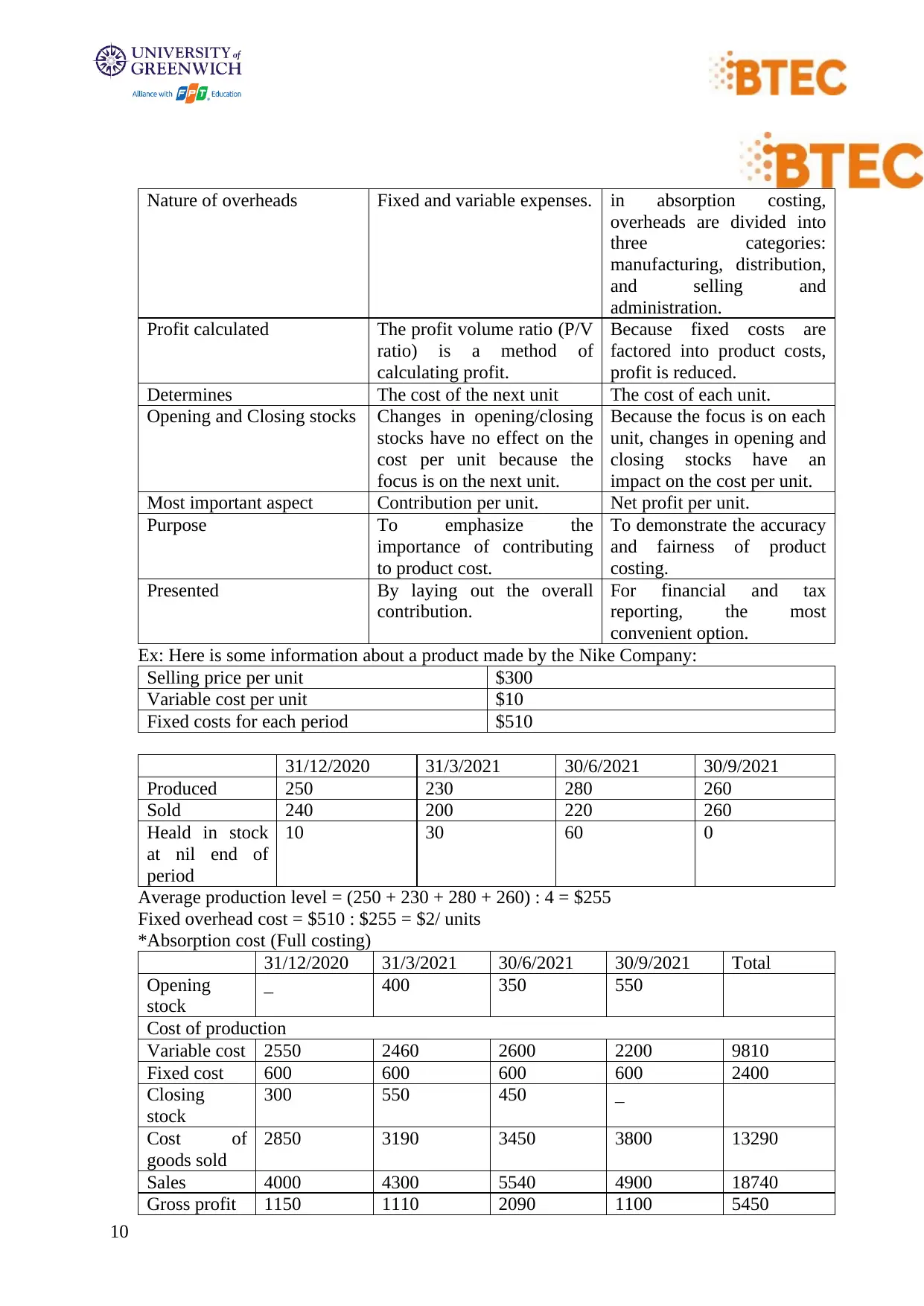
Nature of overheads Fixed and variable expenses. in absorption costing,
overheads are divided into
three categories:
manufacturing, distribution,
and selling and
administration.
Profit calculated The profit volume ratio (P/V
ratio) is a method of
calculating profit.
Because fixed costs are
factored into product costs,
profit is reduced.
Determines The cost of the next unit The cost of each unit.
Opening and Closing stocks Changes in opening/closing
stocks have no effect on the
cost per unit because the
focus is on the next unit.
Because the focus is on each
unit, changes in opening and
closing stocks have an
impact on the cost per unit.
Most important aspect Contribution per unit. Net profit per unit.
Purpose To emphasize the
importance of contributing
to product cost.
To demonstrate the accuracy
and fairness of product
costing.
Presented By laying out the overall
contribution.
For financial and tax
reporting, the most
convenient option.
Ex: Here is some information about a product made by the Nike Company:
Selling price per unit $300
Variable cost per unit $10
Fixed costs for each period $510
31/12/2020 31/3/2021 30/6/2021 30/9/2021
Produced 250 230 280 260
Sold 240 200 220 260
Heald in stock
at nil end of
period
10 30 60 0
Average production level = (250 + 230 + 280 + 260) : 4 = $255
Fixed overhead cost = $510 : $255 = $2/ units
*Absorption cost (Full costing)
31/12/2020 31/3/2021 30/6/2021 30/9/2021 Total
Opening
stock
_ 400 350 550
Cost of production
Variable cost 2550 2460 2600 2200 9810
Fixed cost 600 600 600 600 2400
Closing
stock
300 550 450 _
Cost of
goods sold
2850 3190 3450 3800 13290
Sales 4000 4300 5540 4900 18740
Gross profit 1150 1110 2090 1100 5450
10
overheads are divided into
three categories:
manufacturing, distribution,
and selling and
administration.
Profit calculated The profit volume ratio (P/V
ratio) is a method of
calculating profit.
Because fixed costs are
factored into product costs,
profit is reduced.
Determines The cost of the next unit The cost of each unit.
Opening and Closing stocks Changes in opening/closing
stocks have no effect on the
cost per unit because the
focus is on the next unit.
Because the focus is on each
unit, changes in opening and
closing stocks have an
impact on the cost per unit.
Most important aspect Contribution per unit. Net profit per unit.
Purpose To emphasize the
importance of contributing
to product cost.
To demonstrate the accuracy
and fairness of product
costing.
Presented By laying out the overall
contribution.
For financial and tax
reporting, the most
convenient option.
Ex: Here is some information about a product made by the Nike Company:
Selling price per unit $300
Variable cost per unit $10
Fixed costs for each period $510
31/12/2020 31/3/2021 30/6/2021 30/9/2021
Produced 250 230 280 260
Sold 240 200 220 260
Heald in stock
at nil end of
period
10 30 60 0
Average production level = (250 + 230 + 280 + 260) : 4 = $255
Fixed overhead cost = $510 : $255 = $2/ units
*Absorption cost (Full costing)
31/12/2020 31/3/2021 30/6/2021 30/9/2021 Total
Opening
stock
_ 400 350 550
Cost of production
Variable cost 2550 2460 2600 2200 9810
Fixed cost 600 600 600 600 2400
Closing
stock
300 550 450 _
Cost of
goods sold
2850 3190 3450 3800 13290
Sales 4000 4300 5540 4900 18740
Gross profit 1150 1110 2090 1100 5450
10
Paraphrase This Document
Need a fresh take? Get an instant paraphrase of this document with our AI Paraphraser
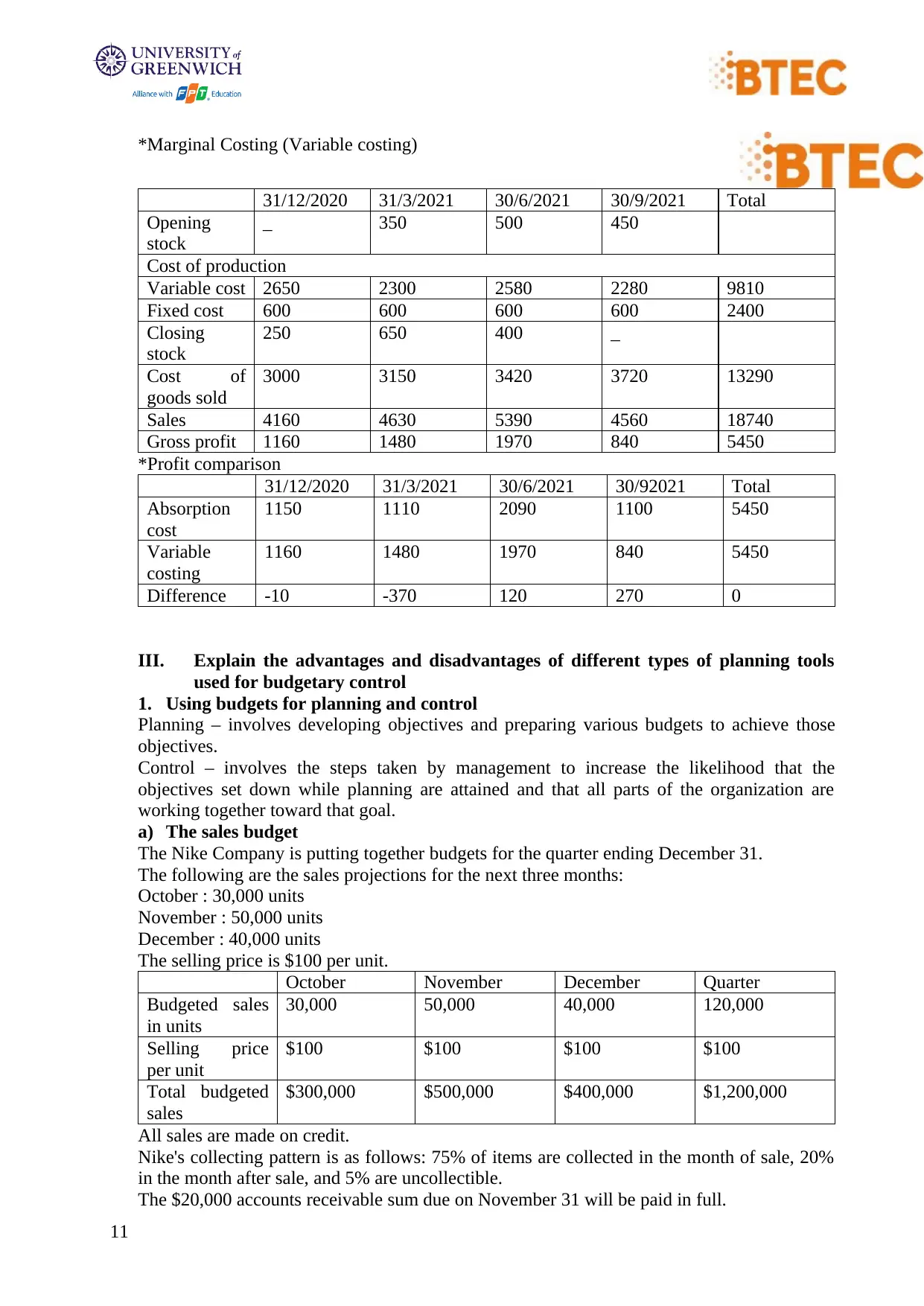
*Marginal Costing (Variable costing)
31/12/2020 31/3/2021 30/6/2021 30/9/2021 Total
Opening
stock
_ 350 500 450
Cost of production
Variable cost 2650 2300 2580 2280 9810
Fixed cost 600 600 600 600 2400
Closing
stock
250 650 400 _
Cost of
goods sold
3000 3150 3420 3720 13290
Sales 4160 4630 5390 4560 18740
Gross profit 1160 1480 1970 840 5450
*Profit comparison
31/12/2020 31/3/2021 30/6/2021 30/92021 Total
Absorption
cost
1150 1110 2090 1100 5450
Variable
costing
1160 1480 1970 840 5450
Difference -10 -370 120 270 0
III. Explain the advantages and disadvantages of different types of planning tools
used for budgetary control
1. Using budgets for planning and control
Planning – involves developing objectives and preparing various budgets to achieve those
objectives.
Control – involves the steps taken by management to increase the likelihood that the
objectives set down while planning are attained and that all parts of the organization are
working together toward that goal.
a) The sales budget
The Nike Company is putting together budgets for the quarter ending December 31.
The following are the sales projections for the next three months:
October : 30,000 units
November : 50,000 units
December : 40,000 units
The selling price is $100 per unit.
October November December Quarter
Budgeted sales
in units
30,000 50,000 40,000 120,000
Selling price
per unit
$100 $100 $100 $100
Total budgeted
sales
$300,000 $500,000 $400,000 $1,200,000
All sales are made on credit.
Nike's collecting pattern is as follows: 75% of items are collected in the month of sale, 20%
in the month after sale, and 5% are uncollectible.
The $20,000 accounts receivable sum due on November 31 will be paid in full.
11
31/12/2020 31/3/2021 30/6/2021 30/9/2021 Total
Opening
stock
_ 350 500 450
Cost of production
Variable cost 2650 2300 2580 2280 9810
Fixed cost 600 600 600 600 2400
Closing
stock
250 650 400 _
Cost of
goods sold
3000 3150 3420 3720 13290
Sales 4160 4630 5390 4560 18740
Gross profit 1160 1480 1970 840 5450
*Profit comparison
31/12/2020 31/3/2021 30/6/2021 30/92021 Total
Absorption
cost
1150 1110 2090 1100 5450
Variable
costing
1160 1480 1970 840 5450
Difference -10 -370 120 270 0
III. Explain the advantages and disadvantages of different types of planning tools
used for budgetary control
1. Using budgets for planning and control
Planning – involves developing objectives and preparing various budgets to achieve those
objectives.
Control – involves the steps taken by management to increase the likelihood that the
objectives set down while planning are attained and that all parts of the organization are
working together toward that goal.
a) The sales budget
The Nike Company is putting together budgets for the quarter ending December 31.
The following are the sales projections for the next three months:
October : 30,000 units
November : 50,000 units
December : 40,000 units
The selling price is $100 per unit.
October November December Quarter
Budgeted sales
in units
30,000 50,000 40,000 120,000
Selling price
per unit
$100 $100 $100 $100
Total budgeted
sales
$300,000 $500,000 $400,000 $1,200,000
All sales are made on credit.
Nike's collecting pattern is as follows: 75% of items are collected in the month of sale, 20%
in the month after sale, and 5% are uncollectible.
The $20,000 accounts receivable sum due on November 31 will be paid in full.
11

October November December Quarter
Accounts
receivable 30/11
$20,000 $20,000
October Sales
75% x $300,000 225,000 225,000
20% x $300,000 60,000 60,000
November Sales
75% x $500,000 375,000 375,000
20% x $500,000 100,000 100,000
December Sales
75% x $400,000 300,000 300,000
Total cash
collections
$245,000 $435,000 $400,000 $1,080,000
b) The production budget
Nike Company management wants closing inventory to be equivalent to 20% of the
following month's budgeted unit sales.
On September 30, a total of 5,000 units were available.
Let's get started on the budget for the project:
October November December Quarter
Budgeted Sales 30,000 50,000 40,000 120,000
Add: Desired
ending
inventory
10,000 8,000 6,000 6,000
Total needs 40,000 58,000 46,000 126,000
Less: Beginning
inventory
5,000 10,000 8,000 5,000
Required
production
35,000 48,000 38,000 121,000
c) The direct materials budget
The Nike Company requires five pounds of material every unit of product. Materials equal to
15% of the following month's production should be on hand at the end of each month,
according to management. 20,000 pounds of material are on hand as of September 30. The
cost of the material is $0.50 per pound. Let's get started on the budget for direct materials:
October November December Quarter
Production 35,000 48,000 38,000 121,000
Materials per
unit (pounds)
5 5 5 5
Production
needs
175,000 240,000 190,000 605,000
Add: Desired
ending
inventory
36,000 28,500 12,500 12,500
Total needed 211,000 268,500 202,500 617,500
Less: Beginning
inventory
20,000 36,000 28,500 20,000
Materials to be 191,000 232,500 174,000 597,500
12
Accounts
receivable 30/11
$20,000 $20,000
October Sales
75% x $300,000 225,000 225,000
20% x $300,000 60,000 60,000
November Sales
75% x $500,000 375,000 375,000
20% x $500,000 100,000 100,000
December Sales
75% x $400,000 300,000 300,000
Total cash
collections
$245,000 $435,000 $400,000 $1,080,000
b) The production budget
Nike Company management wants closing inventory to be equivalent to 20% of the
following month's budgeted unit sales.
On September 30, a total of 5,000 units were available.
Let's get started on the budget for the project:
October November December Quarter
Budgeted Sales 30,000 50,000 40,000 120,000
Add: Desired
ending
inventory
10,000 8,000 6,000 6,000
Total needs 40,000 58,000 46,000 126,000
Less: Beginning
inventory
5,000 10,000 8,000 5,000
Required
production
35,000 48,000 38,000 121,000
c) The direct materials budget
The Nike Company requires five pounds of material every unit of product. Materials equal to
15% of the following month's production should be on hand at the end of each month,
according to management. 20,000 pounds of material are on hand as of September 30. The
cost of the material is $0.50 per pound. Let's get started on the budget for direct materials:
October November December Quarter
Production 35,000 48,000 38,000 121,000
Materials per
unit (pounds)
5 5 5 5
Production
needs
175,000 240,000 190,000 605,000
Add: Desired
ending
inventory
36,000 28,500 12,500 12,500
Total needed 211,000 268,500 202,500 617,500
Less: Beginning
inventory
20,000 36,000 28,500 20,000
Materials to be 191,000 232,500 174,000 597,500
12
⊘ This is a preview!⊘
Do you want full access?
Subscribe today to unlock all pages.

Trusted by 1+ million students worldwide
1 out of 19
Related Documents
Your All-in-One AI-Powered Toolkit for Academic Success.
+13062052269
info@desklib.com
Available 24*7 on WhatsApp / Email
![[object Object]](/_next/static/media/star-bottom.7253800d.svg)
Unlock your academic potential
Copyright © 2020–2025 A2Z Services. All Rights Reserved. Developed and managed by ZUCOL.





